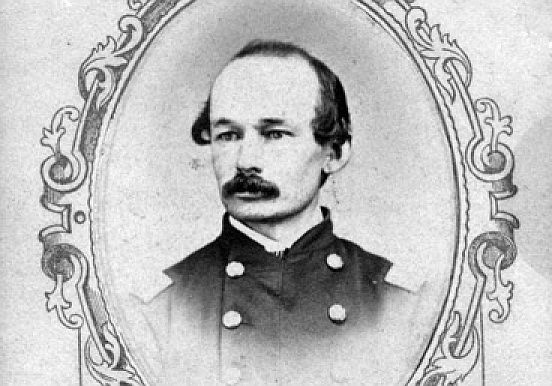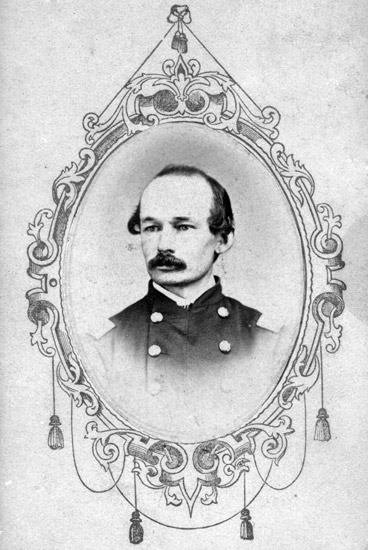The Third Arkansas Cavalry was organized in October 1863 at Little Rock, becoming one of four Union cavalry regiments raised in Arkansas during the Civil War. Led by Col. Abraham Ryan, the Third Arkansas was vital for securing the state for the Union, especially along some of the lawless stretches of the Arkansas River Valley.
Abraham Ryan was born in New York on Feb. 16, 1837, and moved to Illinois as a child. When the Civil War began in 1861, he helped organize Company A of the 17th Illinois Infantry Regiment, mustering in as first lieutenant in May; he was soon made the regiment's adjutant. In the chaotic fighting at Shiloh, Tenn., in April 1862, Ryan commanded a brigade for several hours after its colonel was killed in action, leading to his promotion to captain.
In May 1862, Ryan became chief of staff for Brigadier Gen. Leonard F. Ross. After the Confederate defenders of Vicksburg, Miss., surrendered on July 4, 1863, Ryan was attached to the staff of Major Gen. Frederick Steele during the campaign that led to the Union capture of Little Rock that September. On Oct. 26, 1863, Steele authorized Ryan to begin raising the Third Arkansas Cavalry. Ryan mustered in as colonel of the Third Arkansas Cavalry on Feb. 10, 1864.
On April 5, 1864, Special Order No. 6 commanded Colonel Ryan to take charge of all the troops at Lewisburg, Dardanelle, and the vicinity. Lewisburg, a small town located on the north bank of the Arkansas River, became the station for the Third Arkansas Cavalry. Before the war, Lewisburg had some 300 inhabitants, but lawlessness coupled with retributions carried out by small bands of guerrillas caused most of these citizens to leave the area.
The Third Arkansas Cavalry saw very strenuous service from the beginning. During the months of November and December 1864, they had traveled 100 miles on picket duty, 300 miles on escort duty and 400 miles on scouts. The regiment was composed of 888 farmers, 19 blacksmiths, three physicians, two mechanics, two shoemakers, two carpenters, one miller and one merchant.
This regiment was armed with 880 of Starr's carbines (.54 caliber) and 993 Remington revolvers (.44 caliber), as well as a few sabers. The carbines had been in the hands of the men for a short time, yet were in bad condition. On the other hand, the pistols were in tolerable firing order. Ryan's Third Arkansas was aided in part by local Union captain Jeff Williams and his independent infantry company. They attacked forces led by Confederate colonel Allen R. Witt. Witt had originally organized men from Conway and Van Buren counties into the Quitman Rifles, later known as the 10th Arkansas. Captain Williams and the "Williams' Raiders," along with Witt's guerrillas, turned north-central Arkansas into a no-man's land in which the Third Arkansas Cavalry had to try to maintain civil law and military order.
First Lt. Frank Pease of Company "H" Third Arkansas Cavalry supplied an insight into the operations of the regiment to the adjutant general of Arkansas: "On the organization of the regiment, two battalions were sent up the Arkansas River to hold a large scope of territory infested by numerous guerilla bands, who were robbing and murdering Union families in the most barbarous manner that human depravity could invent. Territory held by these marauders was soon wrested from their hands by the 3rd Cavalry and comparative quiet restored."
During the final years of the Civil War, the Third Arkansas participated in more than 40 different engagements and operations against Confederate forces. The Third Arkansas was mustered out of service on June 30, 1865.
Ryan went into business in Little Rock following the war, serving as the general manager of the Little Rock, Mississippi River and Ouachita Railroad for a number of years. While vacationing on Cape Cod, Mass., in 1873, Ryan rescued two women who were in a boating accident and recovered the bodies of three others who drowned.
In 1880, Ryan moved to East Orange, N.J., where he was active in public and business life. He was president of the Savings Investment and Trust Company and cashier of the People's Bank, with a newspaper proclaiming that "the universal esteem and honor" in which Ryan was held was responsible for the bank's success. He also served on the local school board, was on the Town Committee and did a stint as president of the Orange Art Association.
Ryan was heading home from New York on Dec. 29, 1903, when he died while aboard a train. He is buried at Oak Grove Cemetery in Falmouth, Mass.
-- Ronnie A. Nichols and Mark K. Christ

